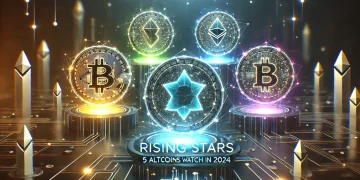Blockchain technology has been hailed as one of the most groundbreaking innovations of the 21st century, poised to transform industries from finance to healthcare. But for many, the concept of blockchain can feel intimidating and overly technical. Terms like “decentralization,” “distributed ledger,” and “cryptography” often make blockchain sound more complex than it is. However, at its core, blockchain is a simple and elegant solution to a very old problem: how to establish trust between parties without relying on intermediaries like banks or governments.
In this guide, we’ll break down the key concepts of blockchain into easy-to-understand terms, unravel its practical applications, and explore why it’s a game-changer in the digital age. Whether you’re curious about Bitcoin, interested in how blockchain can revolutionize industries, or just looking to get a grasp on this buzzword, this guide will help you understand blockchain without diving too deep into the technical weeds.
What is Blockchain?
At its most basic level, a blockchain is a digital ledger of transactions that is replicated across a network of computers. Each of these computers, or “nodes,” maintains a copy of the ledger. This means that no single entity has control over the data, making the system decentralized. Instead of relying on one organization to verify and manage the data (like a bank), the blockchain relies on a collective network to validate and secure transactions.
The data is stored in “blocks,” which are linked together to form a “chain.” Hence, the term blockchain. Every time a new transaction occurs, a new block is created, and once verified, it is added to the chain. This ensures that all the data on the blockchain is transparent and immutable (unchangeable), making it incredibly difficult to tamper with.
Key Concepts of Blockchain
To fully appreciate how blockchain works, let’s break down some key concepts in non-technical terms:
- Decentralization: In most traditional systems, data is stored in one central place (like a bank or a server). In a decentralized system, data is distributed across a network of computers. No single entity controls the information, making it more secure and resilient.
- Ledger: A ledger is just a record of transactions. In the case of blockchain, it’s a digital ledger where all transactions are permanently recorded and can be viewed by anyone on the network. Think of it like a giant, shared spreadsheet that anyone can check but no one can alter without consensus.
- Blocks: A block is a group of transactions that have been bundled together. Once a block is complete, it is added to the blockchain, becoming a permanent part of the ledger.
- Consensus: Since no single entity controls the blockchain, the network needs a way to agree on which transactions are valid. This process is called consensus. Different blockchains use different methods of reaching consensus (e.g., proof of work, proof of stake), but the goal is the same: to ensure that everyone in the network agrees on the state of the ledger.
- Cryptography: Cryptography is a method of securing data. On a blockchain, cryptographic techniques ensure that transactions are secure and that no one can tamper with the data. This is what gives blockchain its robust security.
How Does Blockchain Work?
Let’s break down how a blockchain transaction happens step by step:
- A Transaction Occurs: Imagine Alice wants to send Bitcoin to Bob. She initiates the transaction by sending a request to the blockchain network.
- Transaction is Broadcast: Alice’s transaction is broadcast to all the nodes (computers) in the blockchain network. These nodes will validate the transaction by checking that Alice has enough Bitcoin to send and that the transaction is legitimate.
- Transaction Validation: Nodes in the network will work together to validate the transaction through a consensus mechanism. In the case of Bitcoin, this is done via “proof of work,” where computers solve complex mathematical puzzles to confirm the transaction.
- Transaction is Bundled into a Block: Once Alice’s transaction is validated, it is grouped with other transactions into a block. This block is then added to the existing chain of blocks (the blockchain).
- Block is Added to the Blockchain: After the block is added, it becomes a permanent part of the blockchain. The transaction is now complete, and Bob receives the Bitcoin.
- Transaction is Immutable: Because the block is linked to previous blocks and secured by cryptography, it’s incredibly difficult to alter. The transaction is now forever recorded on the blockchain.
Why Blockchain Matters
Now that we understand what blockchain is and how it works, let’s explore why it’s considered revolutionary. The key features of blockchain offer solutions to some of the major challenges faced by traditional systems.
- Transparency: On a blockchain, every transaction is visible to everyone. This kind of transparency builds trust because anyone can verify what’s happening on the network. For example, in supply chain management, blockchain can allow consumers to track the origin of products, ensuring they are sourced ethically.
- Security: Blockchain’s decentralized nature makes it much harder to hack or manipulate than centralized systems. In traditional databases, a hacker only needs to break into one server to alter data. On a blockchain, they would need to hack a majority of the nodes in the network simultaneously, which is nearly impossible.
- Immutability: Once data is added to the blockchain, it cannot be changed. This ensures that records remain accurate and tamper-proof. In finance, this could reduce fraud, while in legal systems, it could create undeniable proof of ownership or agreement.
- Decentralization: By removing intermediaries (like banks or brokers), blockchain enables peer-to-peer transactions. This reduces costs, increases efficiency, and gives users more control over their own data.
- Efficiency: Blockchain can automate many processes that currently require manual intervention. For example, in the case of international money transfers, blockchain can cut out the middlemen, reducing both time and costs.
Real-World Applications of Blockchain
While blockchain is often associated with cryptocurrencies like Bitcoin, its potential applications extend far beyond digital currency. Here are some examples of how blockchain is being used in various industries:
- Finance: Blockchain’s most well-known application is in the world of finance, particularly with cryptocurrencies. Bitcoin, Ethereum, and other cryptocurrencies rely on blockchain to record transactions. Beyond cryptocurrencies, blockchain can be used for things like cross-border payments, reducing the need for intermediaries like banks.
- Supply Chain Management: Blockchain can improve transparency and accountability in supply chains by providing a permanent record of every step in the production and shipping process. Companies like Walmart and IBM are already using blockchain to track the journey of food products from farm to store, ensuring food safety and reducing waste.
- Healthcare: In the healthcare industry, blockchain can be used to securely store patient records, ensuring that medical histories are accurate and accessible to authorized parties. It can also help with tracking pharmaceuticals to prevent counterfeit drugs from entering the market.
- Voting Systems: Blockchain technology can make voting systems more secure and transparent. By creating a tamper-proof digital ledger of votes, blockchain can prevent voter fraud and ensure the accuracy of election results.
- Intellectual Property: Artists, musicians, and other content creators can use blockchain to protect their intellectual property. By recording ownership and licensing information on the blockchain, creators can ensure they get credit and payment for their work.
- Real Estate: Blockchain can simplify property transactions by reducing the need for intermediaries like brokers and lawyers. It can also be used to create immutable records of property ownership, preventing fraud and disputes.
Common Misconceptions About Blockchain
Blockchain is often misunderstood, and several myths have emerged around the technology. Let’s debunk some of the common misconceptions:
- Blockchain is Bitcoin: Many people equate blockchain with Bitcoin, but blockchain is the underlying technology, and Bitcoin is just one application of it. Blockchain can be used for countless other purposes beyond cryptocurrencies.
- Blockchain is Completely Anonymous: While blockchain can offer a degree of privacy, it’s not completely anonymous. Public blockchains like Bitcoin record all transactions in a way that can be traced back to individuals through their wallets, though their names are not explicitly attached.
- Blockchain is Unhackable: While blockchain is incredibly secure, no system is completely immune to attack. However, blockchain’s decentralized nature makes it far more difficult to hack than traditional systems.
- Blockchain is Just a Fad: Many dismiss blockchain as a passing trend, but its real-world applications and benefits suggest otherwise. As more industries adopt blockchain solutions, its impact is likely to grow, making it a long-term technological shift.
The Future of Blockchain
Blockchain technology is still in its early stages, but its potential is vast. As more industries adopt blockchain solutions, we’ll likely see continued innovation and the development of new use cases. Some trends to watch include:
- Integration with Artificial Intelligence (AI): AI could use blockchain’s transparent data to make more informed decisions, while blockchain could benefit from AI’s ability to analyze data at scale.
- Government Use Cases: Governments may increasingly turn to blockchain for secure voting systems, digital identities, and public records.
- Tokenization of Assets: In the future, we may see the tokenization of physical assets like real estate, art, and even personal data, allowing these assets to be traded more easily on blockchain platforms.
Conclusion
Blockchain is often seen as a complex and impenetrable technology, but at its core, it’s a simple and powerful tool for creating secure, transparent, and decentralized systems. Whether it’s revolutionizing industries like finance, healthcare, or supply chain management, blockchain is set to reshape the way we think about trust, security, and data.
By understanding its basic principles and potential applications, even non-techies can appreciate why blockchain is more than just a buzzword – it’s the foundation of a new digital era.













































